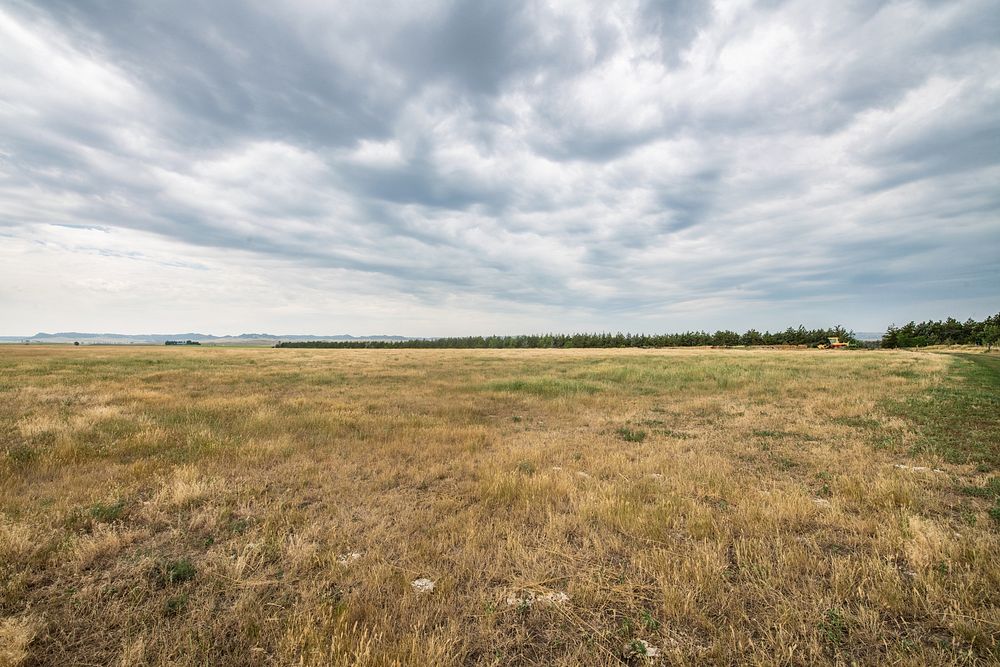
Ranch owners Frank and Jackie Mills utilized the U.S. Department of Agriculture USDA Natural Resources Conservation Service NRCS Windbreak Restoration Conservation Practice 650 to remove dead and dying trees from an existing windbreak, a.k.a.
shelterbelt, and added rows of Junipers on their land in Crawford, NE, in the Great Plains region of the United States, on July 23, 2021. Their windbreak has a tall center row that was originally planted with elm and cedar trees from the 1950s. This row was filled in with cotoneaster (Cotoneaster integerrima) shrubs. To either side are rows of rocky mountain juniper. The two rows facing the farm fields were planted in 2006 and stand approximately 15 feet tall. On the home and farm buildings side are the two rows of juniper that were planted a few years ago as two-year-old juniper saplings. Between the rows is cover grass. The grass includes drought-tolerant smooth brome (bromus inermus) and the lighter bluegrass (dino phinopyrum intermedium) which provides additional weed suppression. The bluegrass is a very aggressive grass that works well to suppress unwanted plants, especially when converting cropland into a windbreak. 24-7 the windbreaks help reduce the wind and snow that if not for them, would erode the soil, and winter snowdrifts would accumulate in greater quantities on and around the Mills' home, barns, and immediate fields. Jackie recalls that her father started constructing windbreaks in the 1950s. He used wood that her sisters had to haul from the yard to the windbreak construction line. Eventually, trees grew to replace the windbreak fence. After the windbreak was installed, you did not notice the wind and snow, when we were in the corral and stables calving, she said, there is such a difference between not having trees and having trees. We are very appreciative of NRCS getting us the assistance. We would not have these trees if it were not for the NRCS assistance program. Growing up, Frank's father worked for 20 years for what was called the Soil Conservation Service in Northeast South Dakota. One of his responsibilities was to help others set up windbreaks. According to Frank, his favorite windbreak plants are the Rocky Mountain Junipers which he says grow great in this area and do a great job at diffusing the wind. The added benefit is that he enjoys seeing wildlife, livestock, and sometimes wild turkey foraging on the juniper berries. A few years ago, Frank saw that several trees were reaching the end of their expected life span. He contacted the U.S. Department of Agriculture USDA, Natural Resources Conservation Service NRCS who was able to cost-share the removal of dead and dying trees. The next year, a fabric mulch was installed along with the new saplings. He says it works great. When asked if his farming and ranching neighbors should do this, he gives an enthusiastic - I recommend it - highly. I think it is a great program - I really do. He adds, because of programs like this, there are more people who do this. The history of the farm begins with Jackie's father Lawrence Raven, who started as a laborer picking corn for the farm owner. Then, one day he asked if he wanted to buy it. Saying yes in 1937, was the start of Martha and Lawrence Raven as producers. Right away Lawrence committed much of the business to the Hereford cattle operation. When they passed, she and her sisters continued the operation. Later, Frank and she bought a portion of the land and started implementing their conservation plan and practices to make life better for them and the land. Resource Conservationist Bryan Kahl from the Chadron field office enjoys helping producers with their conservation plan and to be more productive on the land. He began working for USDA 20 years ago and 15-years ago Kahl was assigned to the Chadron office. The Mills' windbreak restoration was one of his first assignments in the area. While visiting with them, he shows the 15-year-old fabric mulch is still intact and suppressing the growth of weeds and recommends that every several years, the fabric mulch openings should be widened to prevents tree girdling. Kahl enjoys the geographic diversity of the region with the nearby USDA Forest Service FS Pine Ridge National Recreation Area and forests of the region. Most of the region is rangeland. Consequently, grazing system management which includes water development, cross fencing, and promoting rotational grazing is the mainstay of work. In general, windbreak/shelterbelt renovation involves widening, partial replanting, removing, and replacing selected trees and shrubs to improve an existing windbreak or shelterbelt. A period of years may also be needed for proper renovation. USDA Photo Media by Lance Cheung. Original public domain image from Flickr